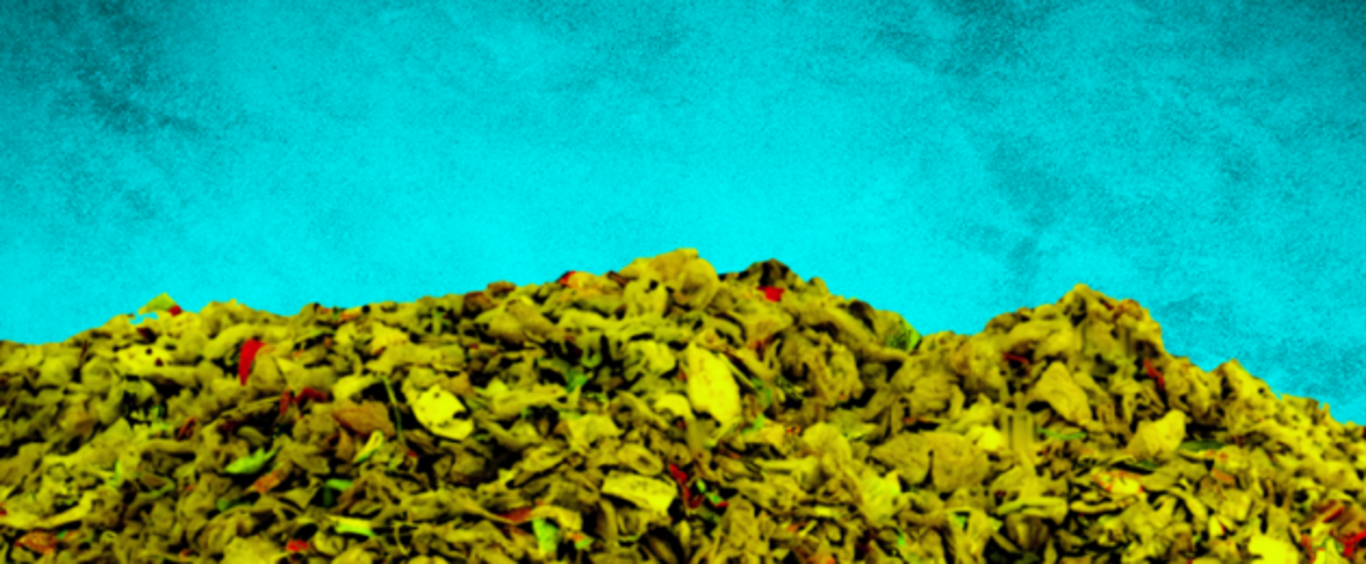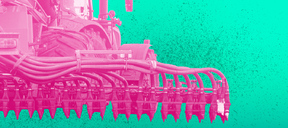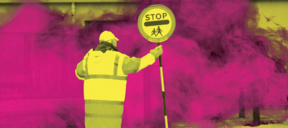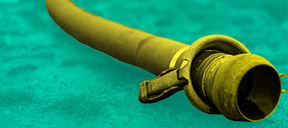Soft plastic is being collected but almost all burned in Irish kilns or recycled abroad
Guidelines changed in 2021 to allow soft plastic in our recycling bins – Noteworthy investigates what happens to it.
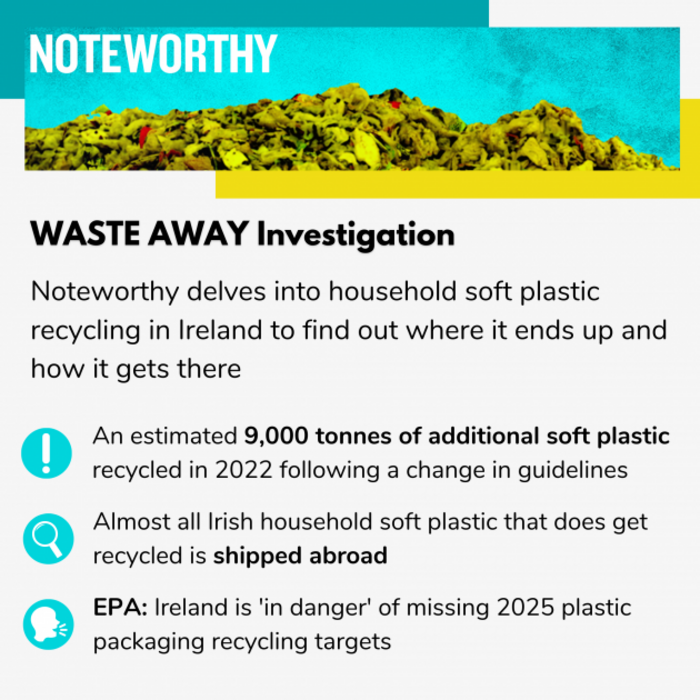
—
THE FRIDGE IS filled with leftovers, and after the frantic weekend of cooking, lunch is turkey sandwiches. You grab the sliced pan and the family polishes off the whole loaf.
Now, you’re standing grimly in front of your overflowing rubbish bins, the clear plastic bread packet empty and crushed in your hand, and you think about how much plastic you’ve already generated this holiday season and how to recycle it, and is there any point anyway?
Put the packaging down and read on! Today, we attempt to find out whether your slice pan pack is likely to have a second life.
In September 2021, the government issued new recycling guidelines. As long as your soft plastic is clean, dry and loose, it should go in the recycling bin.
This was a commitment made in the National Waste Action Plan for a Circular Economy 2020-2025 which promised to “work with the waste sector to encourage investment to allow for the collection of soft plastics and black plastics”.
A circular economy is one where waste is reused and recycled into new products, rather than relying on single use and disposability.
In the background is EU legislation which directs Ireland’s recycling commitments such as the Waste Framework Directive and the European Green Deal launched in 2019 which sets ambitious targets for carbon dioxide and waste reduction.
Public guidelines describe ‘soft plastic’ as plastic that you can scrunch in your hand – a crisp packet, cellophane wrap, a pasta packet. It’s almost exclusively packaging.
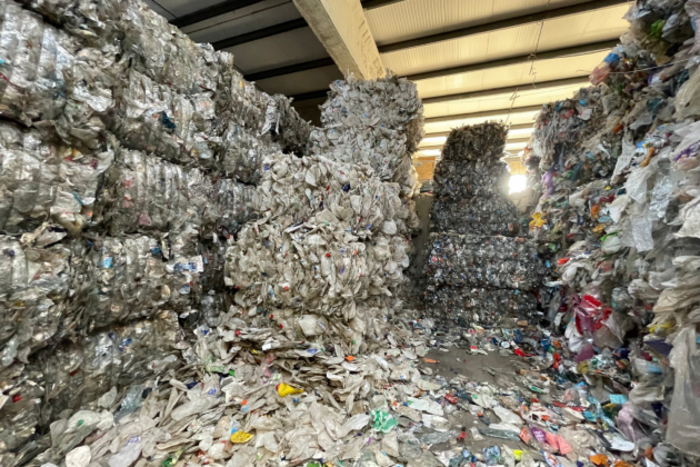 Bales of plastic at the Limerick Polymers Production plant
Bales of plastic at the Limerick Polymers Production plant
The reason we can now put these in the recycling bin, the government says, is because there are new foreign markets for Irish plastic and the waste sorting technology has improved.
So now you are allowed to throw your bread packet in the recycling, what happens to it?
Over the past couple of months for our WASTE AWAY investigation, Noteworthy rooted through recycling waste in Ireland and can now report:
- Soft plastic statistics are not collected separately to other plastics so it is difficult to measure how much is recycled or where it goes
- Waste processors in Ireland are beginning to examine how to turn soft plastics into a resource, but most is exported for recycling abroad
- To have a ‘more straightforward’ system, householders are encouraged to put all recycling waste in one bin, but some industry experts are sceptical that this allows soft plastics to be processed effectively
- An additional 9,000 tonnes of soft plastic was expected to be recycled within 2022, according to Repak
- Over 70% of all plastic packaging was burned in cement kilns or energy plants, according to latest EPA statistics from 2020, though household soft plastic has only been collected since 2021
- Some of the main supermarket chains are attempting to reduce virgin and non-recyclable plastic, but two of the largest chains – Dunnes Stores and SuperValu – did not provide any response to our investigative team
You can also explore our findings by listening to The Explainer x Noteworthy podcast on this investigation:
‘Sorting is the hardest part’
When trying to get your head around recycling in Ireland, the first thing to know is that waste can be broadly split by origin into post-industrial and post-consumer waste. Picture the wooden pallets with machine parts being loaded out of a truck, all wrapped in clear plastic wrap – that is post-industrial.
Post-industrial waste might be challenging in other ways, but when it comes to post-industrial plastic packaging, it’s generally more straightforward.
It is “typically cleaner and easier to deal with because the factory will have someone sorting it there, it’s one stream”, explained Mark Sheahan, general manager at Limerick Polymer Production, a new plastic sorting facility that deals exclusively with post-consumer plastic waste.
Your sliced pan packet and anything else you throw away at home is post-consumer. This includes paper, cardboard, metals and plastic.
“Sorting is the hardest part,” says Sheahan. The bitty nature of the waste in our recycling bins is what makes it difficult to turn into a valuable commodity. “The reason the post-consumer material hasn’t been recycled before is because [the pieces are] not big enough,” to make it worthwhile he says.
There’s a chance that your sliced pan packet will end up at a plastic sorting facility but first it has to pass several other steps.
The post-bread life of a sliced pan pack
Ireland’s recycling system is unique in the EU because it’s the only one that’s almost fully privatised. Households pay a company to collect their bins and that company loads all your recycling into a truck.
These companies get their permits from the National Waste Collection Permit Office (NWCPO) based in Offaly County Council, the “nominated authority”.
You need a permit if you’re doing “[waste] collection for profit or reward or otherwise in the course of business”, explains Leo Duffy, the programme manager. The NWCPO carries out audits on waste collection applications and gathers annual waste collection data.
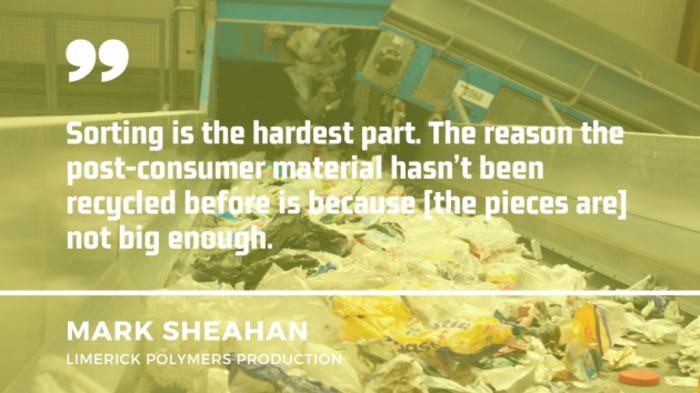
Soft plastic is very difficult to deal with, Duffy said, and it used to be considered a contaminant if it got in amongst other materials.
He explained that prior to 2016 what was allowed in the recycling bin wasn’t specified. Soft plastic was then excluded from the list when they standardised it that year.
“It was to do with the equipment that was there,” he said. Soft plastic was “reintroduced [in 2021] because obviously we need to start recycling these”, especially given the context of the new government Waste Action Plan.
Now, when it comes to soft plastics, “there are operators who are starting to look at them and turn them into a resource”, which he said is a game changer.
But he said that “the big thing here is going to be the general public”, and added: “If the general public don’t segregate their waste there’s very little these guys can do.”
In their guidelines, the Irish authorities have tried to make things as easy as possible for households. Unlike other EU countries, Ireland does not segregate its recycling. There is one bin for general waste, one for recycling and possibly one for food and garden waste – depending on where you live.
This is an easy message to communicate and means that the material is there to be recycled as the technology improves.
“By putting all your recyclables in the recycling bin, we can ensure more of them are recycled over time,” said Pauline McDonogh, of My Waste, Ireland’s official website for guidance on managing waste. She added:
The addition of soft plastic to the Irish household recycling bin makes waste segregation much more straightforward for the householder.
This is a strength and a weakness, however, and some in the Irish waste industry are sceptical that we have the ability to deal with soft plastics meaningfully.
When rubbish trucks collect recycling waste, they compact it, meshing it together which risks making it difficult to separate.
Households do something similar on a smaller scale when they pack recyclables together; imagine an Easter egg with all its packaging – foil, plastic and paper – if you put all that back in the box together, and that gets compacted, it makes it a lot more difficult to separate.
One of the only plants that actually recycles plastic within Ireland is Shabra in Monaghan, producing new plastic products for the Irish market. It won’t take post-consumer waste for this reason – it’s too hard to sort.
Brian Finnegan, director of operations at Shabra is sceptical about Ireland’s ability to sort post-consumer soft plastics to a purity required to make them useful.
“We should be reducing and not recycling all these soft plastics,” he said, adding that the decision to allow them in the recycling bin is motivated by how much is currently burned.
Over 70% plastics burned
According to the latest figures from the Environmental Protection Agency (EPA) from 2020, 71% of plastic packaging (soft and rigid) – just under 220,000 tonnes – was burned for energy recovery in 2020.
Energy recovery is when waste is burned, in place of other fuel. In Ireland that is either in cement kilns or power plants and in the waste treatment hierarchy, it is a less desirable outcome than reducing, reusing or recycling waste.
Ireland has to meet EU recycling targets. We have so far met the target of 25% of plastic packaging produced being recycled but that will jump to 50% by 2025 and 55% by 2030. The EPA warned in December that these targets will be “very challenging” to meet.
“Ireland is in danger of missing future (2025) EU municipal waste and plastic packaging recycling targets,” it wrote in its latest report which analysed 2020 data. It stated that 29% of plastic packaging is recycled.
“Recycling rates remain worryingly low for plastic packaging with a continuing trend towards energy recovery,” the EPA also stated.
There’s also a reason My Waste insists that soft plastic must be “clean, dry and loose” – contamination from food is a problem, but if citizens don’t adequately separate their waste it can be impossible to do so in a Material Recovery Facility – which is the next step in the slice pan packet’s journey.
Struggling on the first sort
After being collected, your sliced pan pack and all your other recycling gets delivered to a Material Recovery Facility or MRF (pronounced ‘murf’ by those in the industry).
That’s where the recycling undergoes an initial sort. There are nine in the country.
MRFs are good at sorting rigid plastics, cardboard and metals like aluminium – but they struggle with soft plastic.
“MRFs will have a spectrum of different technologies, some highly sophisticated, some less sophisticated but still very effective,” said Tom Gaynor of Repak, the body responsible for packaging recycling in Ireland.
Repak charges producers who put packaging on the market and then redistributes that money to help fund recycling. Gaynor told Noteworthy:
They need to produce purity and consistency of polymer type. The purer and more consistent does better on the market.
A plastic polymer refers to the chemical composition of the plastic. Not all plastics have the same molecules arranged in the same way, that’s what gives us clear or cloudy, soft or rigid plastics. If a bale of plastic after sorting is mostly the same polymer, Gaynor also explained, the MRFs will get more funding from Repak.
Some plastics, such as rigid plastic milk bottles, made of a type of plastic called high-density polyethylene (HDPE), are relatively straightforward to recycle. They’re large which makes them easy to sort and they’re valuable enough to make it worth it because they’re a single polymer.
That means that there’s no extra step needed before they can be washed and made into pellets which are then turned into new plastic milk bottles.
“The MRFs in general are looking to produce a grade that it is able to sell onto the market,” said Brian Heffernan of the National Transfrontier Shipment (TFS) Office – the office responsible for tracking Irish waste import and export. “That would be their primary function.”
In the best case scenario, your sliced pan packet will have been sent to an MRF that recognises it as a plastic polymer and bales it up with other polymers to be recycled or further refined.
Worst case scenario, which happens the majority of the time in Ireland right now, it will be recovered – which means that it will replace fuel in energy plants, or in one of Ireland’s four cement kilns.
If it’s baled up and sold, it could go abroad, but since March 2021 there’s also a new sorting plant in Ireland where it might go.
New plastic plant
Limerick Polymer Production is the first purpose-built post-consumer plastic sorting facility in Ireland. It was issued its Waste Facility Permit one month after the guidelines on soft plastic changed.
Noteworthy visited the plant at the start of December 2022.
“Anecdotally, there has been a change [since September 2021],” said general manager Mark Sheahan. “The MRFs are now producing more soft plastic.” He said that while there are definitely still soft plastics incorrectly going into the waste bin, the publicity drive around recycling them does seem to have had an effect.
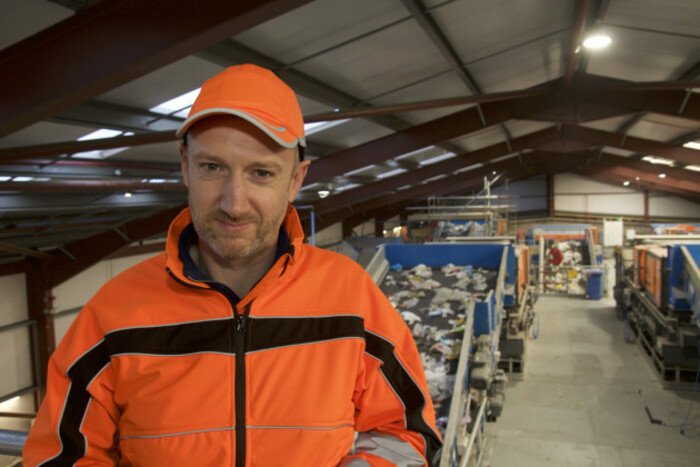 Mark Sheahan, general manager at Limerick Polymer Production
Mark Sheahan, general manager at Limerick Polymer Production
Sheahan said it depends on the MRF but they might receive a bale of plastic that is maybe 90% plastic, and that they are “trying to produce a product at the other end that’s 98, 99% purity of a particular polymer and a particular colour”.
Colour is important. Virgin plastic is clear (like your sliced pan bag) and that’s the most useful kind as it can be turned into anything.
When product designers colour their plastic packaging it’s less versatile as a recycled material. Sheahan used the example of biscuit trays. He said: “Don’t make them black! Once it’s black, it can only ever go into black again.”
The plant says on its website: “As a direct result of the LPP facility in excess of 10,000 tonnes of additional film will be recycled in Ireland in 2022, this represents a 53% increase on 2021.”
However, it declined to share information with Noteworthy on where it buys its plastic waste or the tonnages it processes and sells to different plants because, Sheahan explained, it’s commercially sensitive information.
“While we take material off [the MRFs] and all that, we’re all in business kind of against each other,” he said. “We don’t want them to be thinking maybe we’ll build a big plant ourselves now and start doing this. We don’t want them to be able to figure out the financials.”
LPP has spent €18 million on the plant which has a licence to process over 50,000 tonnes of plastic a year – both soft plastic which is referred to by the company as “film” and rigid plastic.
Currently, when they run film they can process six to seven tonnes an hour; when it’s bottles they can run 14-15 tonnes an hour. “We run a lot quicker on bottles.”
The plant is fully automated – Sheahan told Noteworthy that it only needs eight people to run it, and there are no hand pickers.
When the MRFs send LLP a mix of soft plastic, the plant is able to separate it even further into different waste streams.
When Noteworthy visited the plant the first thing we noticed was the smell – there’s almost none. In Ireland, waste is not allowed to be stored outside and so the packaging doesn’t get wet and smelly.
The second was the noise – machines stacked to the roof whirring and sorting plastic make it difficult to talk. Streamers of plastic that had fallen off the conveyors hung festively from some of the walkways.
A Norwegian multi-national, Tomra, has produced many of the machines. They are available worldwide and buying them is straightforward. Sheahan said that the layout of the plant was what the LPP team spent months researching and developing.
In one section, optical sorters scan a black conveyor belt of plastic packaging with a laser and then blow different types into different sections. The plastic goes through multiple machines like this at impressively high speed.
 An optical scanner at the Limerick Polymers Production plant identifies plastic and then sorts it at high speed
An optical scanner at the Limerick Polymers Production plant identifies plastic and then sorts it at high speed
Near the entrance, bales are stacked up ready to be loaded into lorries and moved on. Some are monochrome bales of milk bottles, others are made of multi-coloured shopping bags, others of bright crisp packets.
All of the bales of soft plastic they produce are currently sold abroad. The dross – waste that they sort out of their plastic – is burned as solid recovered fuel in Ireland.
“Export is always going to be part of the story,” said Tom Gaynor of Repak. All experts that Noteworthy talked to explained that Ireland isn’t big enough, and hasn’t produced enough waste, to make building the infrastructure commercially viable.
However, as technology improves, Ireland may be able to recycle at home. LPP already has plans to build a wash line and extruder at their site which means post-consumer soft plastics could be recycled here for the first time.
Sheahan said that technological advances, new environmental legislation and new Repak funding had mitigated the risk of building the Limerick plant, especially when it comes to the less valuable forms of plastic.
“Things that are more difficult to recycle” will be heavily subsidised, Sheahan explained. “Then, as a product or material becomes easier to recycle, they’ll reduce their subsidies. So they’re like a bit of a crutch to try and get the material dealt with.”
There is also more support for research into how to improve technologies, with a new Polymer Centre of Excellence, run by the Technological University of the Shannon, opening in 2023 and looking at how to make plastics more recyclable.
Almost all plastic sent overseas
Anything that can be recycled is given a waste code that is used to track where it goes.
“This all came into play because back in the 1980s and 70s the Northern Hemisphere was dumping [a lot of] its hazardous waste on the developing countries,” explains Brian Heffernan of the National Transfrontier Shipment (TFS) Office.
The result of the scandal was the Basel Convention which created waste codes, and since then the EU also implemented its own waste tracking system. “It’s highly regulated but necessarily so,” Heffernan added.
The category of ‘soft plastic’ is hard to track, however, because it isn’t a category at all. There are Basel and EU codes for “plastic” but not soft plastic specifically.
Soft plastic is also not a technical term, it’s a simplified term for consumers.
The EPA collect stats on plastic in general, and industry experts we spoke to tended to refer to plastic by its polymer type: an alphabet soup of PP, PET, HDPE… but mostly its referred to it as “film” as opposed to the other type of post-consumer plastic packaging – “pots, tubs and trays”.
For this reason, it’s difficult to measure how much soft plastic Ireland has brought into the recycling stream since it changed the guidelines, and it’s difficult to know where it goes.
The EPA will not release official figures for 2021 until next year but Repak told Noteworthy:
Additional soft plastic recycled within the full year 2022 is expected to be approximately 9,000 tonnes.
However, we can be pretty sure most of our soft plastic that does get recycled goes overseas.
LPP sells all of its plastic to foreign markets and the latest EPA report said: “Of the packaging material that was recycled in 2020, almost all plastic (92%) and paper/cardboard (99%) was exported abroad for recycling.”
Waste export is regulated by international, EU and Irish law and broadly there are two export streams: green-listed waste and amber-listed waste. If waste qualifies for the green list, the controls are looser; amber and they’re tighter.
Is household recycling green or amber? “That’s the million dollar question,” said Brian Heffernan at the TFS Office. “Once it’s sorted sufficiently well it can be green.”
Heffernan told Noteworthy that roughly one million tonnes of each green list waste and amber list waste is exported each year.
For household recycling to qualify as green list, it must be non-hazardous, destined for recovery (which, in waste export terms, means both recycling and burning for energy recovery in, for example, a cement kiln) and it must be of sufficient purity.
If it’s not destined for an EU or OECD country, additional safeguards are in place.
There are specific purity thresholds for plastic: “We’ve 2% and 6%,” said Heffernan.
“If I want to ship plastic from Ireland to Spain and it’s a single polymer, the level of non plastic cannot exceed 6%. But if I want to ship that same material outside the EU (including Great Britain) that level is down at 2%.”
The difference, he said, was that the EU Commission believes that for plastic that stays inside the EU, there’s a greater confidence that the waste will be dealt with in accordance with environmental and health standards and so there’s more allowance given. They’re stricter when it leaves the EU.
“Plastic is still only around 10% of the total green list, and roughly half of that would stay in the EU,” Heffernan said.
This is for plastics in general, and includes soft plastic both from household waste and commercial. There’s about 95 thousand tonnes of plastic exported; 50,000 stays in the EU, 30,000 goes to the UK and about 10,000 goes to Turkey, Heffernan added.
A waste company applies for a licence to export green list material on a yearly basis and sends a form with each shipment. Inspectors from the TFS Office ensure compliance with site visits and spot checks in Irish ports.
“TFS have been in here maybe four times this year for random inspections, audits, checking everything,” said Sheahan of Limerick Polymer Production, who added that “they open containers in ports… once or twice a week”.
“It’s to make sure people aren’t exporting rubbish and saying ‘this is recycled’.”
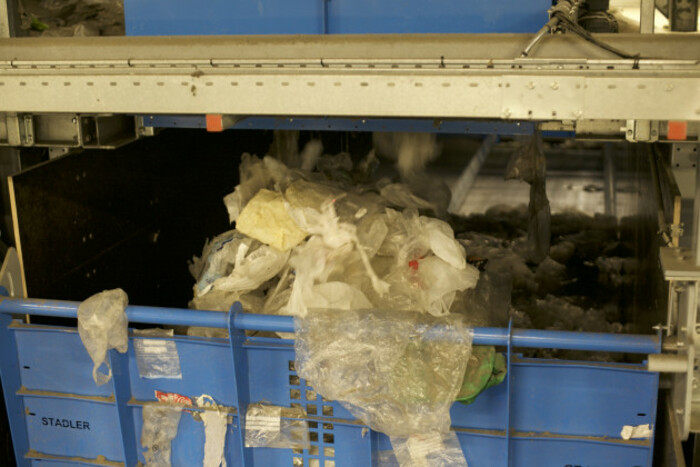 If the batch of sorted plastics that your bread packet ended up in is of sufficient purity (2%), it may be recycled outside of the EU.
If the batch of sorted plastics that your bread packet ended up in is of sufficient purity (2%), it may be recycled outside of the EU.
He said it was “not even unlikely” that green list waste would be disposed of improperly abroad. “It would never happen – once the material goes out that’s a good enough quality, it’s too valuable.”
Although there are no waste codes specifically for post-consumer soft plastic, Noteworthy analysed the TFS office’s Public Register of Green List Waste 2021.
We found that plastic bales – that likely included soft plastic – mostly ended up in the EU, Northern Ireland, Great Britain, Turkey and the US. The top export countries were Turkey, Germany and Portugal.
Some household waste might be shipped out as amber list waste, if it’s a bale of mixed polymers.
Amber list waste is more tightly controlled – it doesn’t go outside the OECD for example. “Plastics will be treated as amber-list if they are either hazardous or mixed with other wastes to an extent that the relevant threshold is exceeded,” said Heffernan.
Noteworthy analysis of the Public Register Amber List Waste 2021 showed that bales of amber-list waste that likely included soft plastic all ended up in Northern Ireland and Great Britain.
Heffernan said that “with 2 million tonnes leaving there’s a limit to the amount of physical containers [the TFS] can inspect”.
Putting ‘pressure on the producers’
The question of where your soft plastic ends up depends as much on what happens before you throw it away as after.
Consumers can make a difference. Don’t fill your sliced pan packet with other recycling waste, instead put it all loose in the bin. Avoid buying anything with packaging that’s a mixture of plastics and cardboard or other material that you can’t separate yourself at home.
Fully pull apart the film and the rigid tray of your pack of sliced cheese so they can be sorted into their different polymers. If in doubt, check whether something can be recycled on a site such as My Waste.
However, it’s not all down to the consumer. There’s a tension between design and recyclability, with experts that we spoke to saying there was a lack of joined up thinking if Ireland wants to really make a circular economy work.
“Producers make packaging that will make their product look good,” explained Mindy O’Brien, head of the environmental NGO VOICE Ireland.
I think you need to continue to put pressure on the producers and designers to cut down or eliminate [packaging].
It’s not just about cutting down on packaging – plastic packaging has a role and helps keep our food safe and prevents food waste – it’s also about designing packaging that can be recycled.
For example, a product made of plastic laminate – multiple layers of different plastics – may have fulfilled a designer’s brief but will also make it more difficult to recycle. Similarly, your well-designed plastic bread packet suddenly becomes more difficult to recycle if the producer or supermarket sticks paper labels on it.
Then there’s the printed design on the packaging. One Irish packaging manufacturer explained to Noteworthy that they are sometimes asked to print instructions on packaging that say it is not recyclable when in fact it is, often due to marketing teams not understanding recycling rules.
My Waste, the government organisation, has a blog post acknowledging how confusing the different recycling symbols are for consumers, and explaining them. However, it stresses that if packaging is clean, dry and loose then it can all go in the recycling bin.
Noteworthy asked the five largest supermarket chains in Ireland about the actions they were taking on plastic packaging design as well as waste in their shops.
A spokesperson for Aldi told us that the chain had “removed more than 2,150 tonnes of virgin plastic” from its 155 store network in Ireland and “replaced 930 tonnes of unrecyclable material with recyclable alternatives”.
As an example, they said the company removed “all plastic packaging” from its entire seasonal wooden toy and plush range ahead of Christmas”. The spokesperson added: “Now, this range’s packaging is made from 93% recyclable materials.”
This was part of its “pledge for all packaging to be reusable, recyclable or compostable by 2025”.
Lidl gave a lengthy reply. A spokesperson said that in 2021, the chain “removed all unrecyclable black plastic” from its range. “We work towards a clear first policy, preferring clear and lightly coloured plastics.”
It has also introduced recycling stations in its shops so that customers can dispose of excess plastic after the checkout. The spokesperson also said that Lidl segregates this plastic waste more than domestic recycling would, thus saving the customer money and increasing the efficiency of the recycling.
They added: “Moving to a different packaging solution for a product depends heavily on customers and their willingness to accept changes.”
Lidl also recruited a “packaging technologist” who educates the chain’s buyers and suppliers in packaging and recyclability. The spokesperson said “optimising packaging is a priority throughout new and existing product product development”.
Like Lidl, Tesco has also introduced plastic recycling units in their stores.
Tesco works “together collaboratively on removing all non-recyclable packaging, on reducing packaging and to ensure all our packaging is recyclable”, according to a spokesperson.
They added that this has led the supermarket to create the ‘Tesco Packaging Preferred Materials List’ to inform its suppliers and its own business of what packaging to use.
They also told Noteworthy that waste plastic is collected from its stores and sent to Paltech, an Irish manufacturing company, “where plastic is flaked and prepared for processing into construction materials” to be used in Tesco’s store network”.
One example Tesco gave Noteworthy of a packaging redesign was its 150ml yoghurt packaging “so the outer layer is removable from the tub which will ensure recyclability of both layers”.
Neither Dunnes Stores – who has the largest Irish grocery market share – nor SuperValu replied to our requests for comment.
The future of packaging recycling
“As we go into our supermarkets,” said O’Brien, “we see a lot of things that are wrapped up in plastic and that’s purely for ease of the supermarkets – for ease of packing and stacking.”
She warned that we shouldn’t just switch to other forms of packaging, a process which is called “unfortunate substitution”, rather we need to see how we can do without packaging at all.
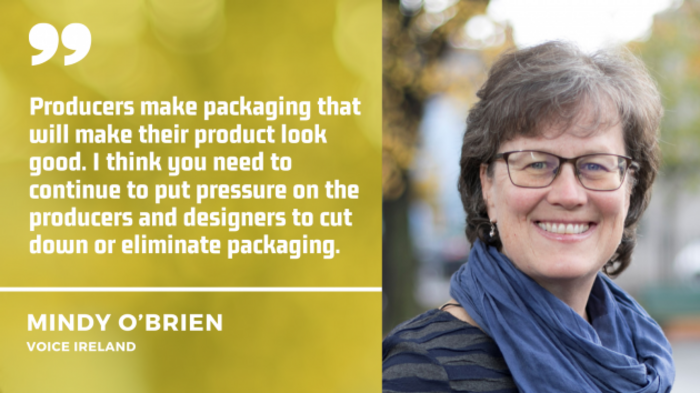
“I think it definitely has to be resolved by legislation,” she added. A lot of industries, including supermarkets, have made voluntary commitments but “unless the government mandates that they have to do such actions, they won’t do it”.
O’Brien uses the example of recent EU legislation that stated that hard plastic PET drink bottles must soon be made of at least 30% recycled plastic. This has led to a rise in the value of recycled PET and induced Ireland to create a deposit return scheme to collect PET bottles that will begin operating in 2024.
New EU legislation, proposed in November 2022, will go further in trying to reduce packaging, including soft plastic. The legislation would aim to restrict unnecessary packaging and “make all packaging on the EU market recyclable in an economically viable way by 2030”.
It would also address the labelling problem: “Every piece of packaging will carry a label showing what the packaging is made of and in which waste stream it should go… The same symbols will be used everywhere in the EU.”
Where does this leave your bread packet? Since it’s clear soft plastic, it’s probably made of low-density polyethylene (LDPE). If it makes it to Limerick, it would be baled up with all the other clear plastic LDPE and likely sent across the Irish Sea in a shipping container to the UK or to mainland Europe.
From there, it would be cut into tiny pieces, washed and then turned into plastic pellets. These pellets would be bought by a packaging factory and used to make new recycled LDPE products. If it’s turned into new film, it will probably look slightly cloudy, unlike virgin plastic which is totally clear.
It won’t be used to package sliced pan again – recycled plastic is only included in food-grade products when the origin is clear and the manufacturers can be sure it never came into contact with contaminants.
However, it could become many other things: a plastic bag, or a bin liner, or a film wrapping that doesn’t touch other food. But only if you throw that scrunched up piece of plastic in your hand into your recycling bin.
—

Have a listen to The Explainer x Noteworthy podcast on our findings

By Alice Chambers of Noteworthy
This investigation was proposed and funded by readers of Noteworthy, the investigative journalism platform from The Journal.
Please support our work by submitting an idea, helping to fund a project or setting up a monthly contribution to our investigative fund HERE>>

